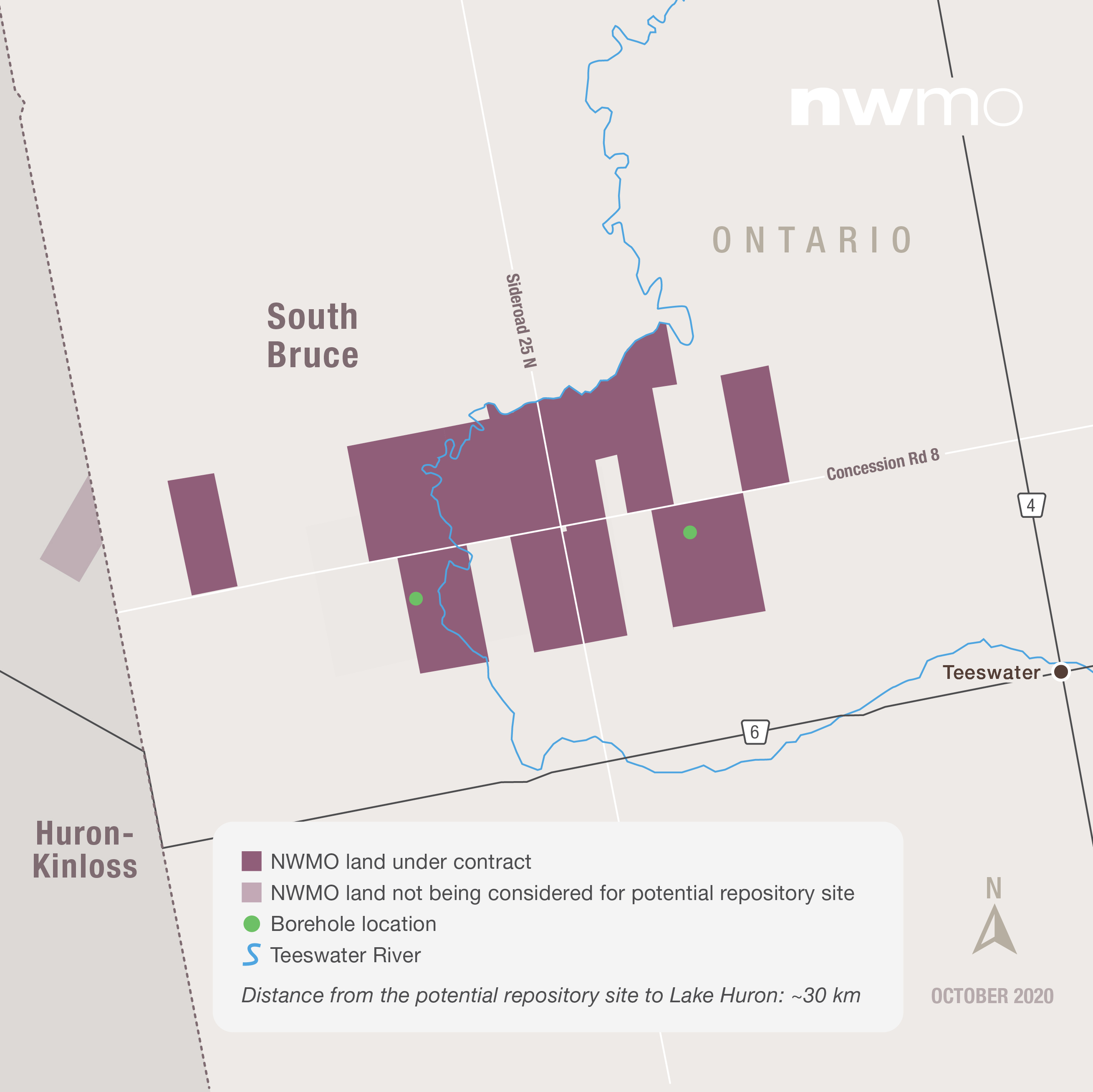The Nuclear Waste Management Organization (NWMO) has signed more agreements with land owners in South Bruce.
Today, the NWMO shared a map showing the potential deep geological repository site in South Bruce, outlined next steps to confirm safety at the site, and made a commitment to protect property values in the area if it is selected to host a repository. South Bruce is one of two potential hosts in the site selection process for a deep geological repository for Canada’s used nuclear fuel; the assessment process is also underway in the area around Ignace, Ontario.
Earlier this year, the NWMO announced it had signed agreements with landowners in South Bruce for 1,300 acres. Since then, the NWMO has secured just over 1,500 acres north of Teeswater, Ontario. The agreements include a combination of option and purchase arrangements that allow the NWMO to conduct studies while allowing landowners to continue using the land.
“This is an important milestone in South Bruce, and an expression of confidence in the project. We are thankful for the continued interest in our land access process, and know there is much more to do as we work toward assessing the potential suitability of the site,” said Dr. Mahrez Ben Belfadhel, Vice-President of Site Selection at the NWMO.
The milestone will allow important site assessment work to continue as the NWMO moves to identify a single, preferred location for a deep geological repository.
“We will begin preparatory work for two exploratory boreholes in the near-term, and expect to begin drilling the first in April, 2021. Discussions with local landowners in the vicinity of the potential site will continue over the coming months and years,” said Dr. Belfadhel.
Technical site evaluations, such as borehole drilling and environmental baseline monitoring, are key next steps for the site. At the same time, the NWMO will continue to seek input and address questions from residents through open houses, exhibits, meetings and other engagement activities.
“The plans announced today recognize and address concerns which have been raised in the South Bruce community” said South Bruce Mayor Robert Buckle. “I appreciate that the NWMO is demonstrating that they are working with the residents through this process.”
Of the total potential repository site, the NWMO requires 250 acres for facilities on the surface. The specific location of these facilities on the site has not yet been determined. The remainder will continue to be used as it is today.
“A key part of the agreements with local land owners is to support local economic activity by ensuring farming will continue to be the primary economic activity on the site,” said Dr. Belfadhel. “We’re committed to protecting the environment and farmland, while also minimizing disruption to local businesses.”
Property value protection
As part of the land access process, the NWMO committed to develop, in consultation with the municipality of South Bruce, a program to compensate property owners if property values are adversely affected by the project. This property value protection program will be developed as part of a series of well-being studies that the NWMO plans to complete with the involvement of the community in 2021.
Next steps: site assessment and borehole drilling
As previously mentioned, accessing land in South Bruce will allow the NWMO to conduct site assessment activities to ensure the area and its geology can safely host a deep geological repository for used nuclear fuel in a manner that protects people and the environment for generations to come. As such, the NWMO is beginning to plan for two exploratory boreholes to confirm understanding of geology at the site. Site preparation activities for boreholes will occur this fall so drilling can begin in 2021.
As part of drilling best practices, the NWMO will test private water wells at and near the borehole sites.
In addition to borehole drilling, the NWMO is planning additional field activities in 2021 to further characterize the geology. These include:
- employing microseismic monitoring stations across the region to monitor for seismic activity, such as low-magnitude earthquakes;
- installing shallow groundwater monitoring wells to study the hydrogeology of the area; and
- conducting geophysical studies in the area to assess the suitability of the area to host a repository.
Environment Baseline Monitoring Program
Site assessment will also include environmental monitoring to create a baseline of understanding to ensure the NWMO can minimize any effect Canada’s plan may have.
Earlier this year, the NWMO hosted a series of virtual and in-person workshops to gather community input into the environmental baseline monitoring program. Led by the NWMO’s environmental and engagement teams, the workshops provided valuable input to advance our understanding of the specific needs and environmental interests of many community members.
Participants provided a wide range of input during the workshops. The protection and monitoring of water was one focal point. Based on this feedback, the NWMO environmental baseline monitoring program will also include monitoring of private water wells on and near the potential repository site, as well as the Teeswater River.
Working together
The NWMO remains committed to working with communities as it moves towards selecting a site for Canada’s plan.
Similar studies are also continuing in the area of Ignace, in northwestern Ontario, where the other potential repository site is located. The NWMO expects to identify a single, preferred site to host the project, in an area with informed and willing hosts, by 2024.
While the NWMO continues to engage with Saugeen Ojibway Nation, other Indigenous communities, and local municipalities, the aggregation of land in South Bruce does not suggest it has provided its support for the siting of the repository in this area.
Learn more
The NWMO is hosting an Open House from October 26 – November 7. We encourage members of the community to attend to gather more information about the project and our upcoming work. Residents can also visit the NWMO Learn More Centre in Teeswater Monday – Friday from 9 am - 4 pm.

